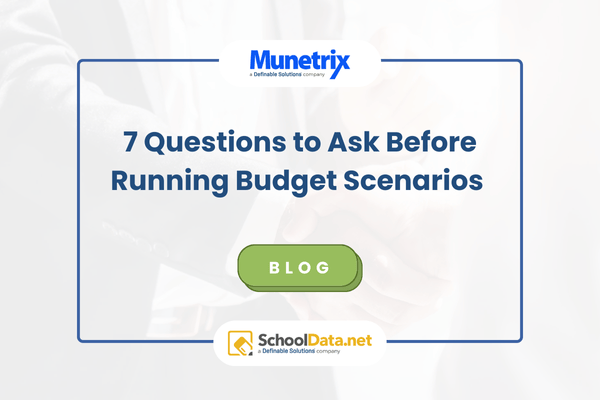K–12 districts across the country are facing a sudden and significant shift in their financial landscape. As a district administrator, you may be wondering: How deep is the funding gap? How far will your fund balance stretch? And how can you build consensus around the changes your district needs to make to stay solvent and successful?
Fortunately, you don’t have to face these questions alone.
Jason Helsen, Associate Executive Director of the Michigan School Business Officials (MSBO), recently hosted a webinar packed with practical budgeting strategies to help school leaders prepare for potential legislative changes and financial uncertainty. With so many districts confronting the same challenges, Helsen encouraged administrators to use all the tools and trusted resources available — there’s no need to go it alone.
You may already have more support at your disposal than you realize, including peer networks, expert advice, and powerful tools that bring clarity to complicated budget decisions.
Watch Jason Helsen’s full webinar here.
Look to trusted tools
Most administrators don’t have the time to build their own spreadsheets from scratch or interpret the latest state budget line by line. That’s why it’s essential to start with tools designed for the real-world challenges of school finance.
The Finance application from SchoolData.net was built specifically for K–12 administrators like you, enabling you to:
- Run multiple budget scenarios with an easy-to-use budget builder
- Represent fund balance data and expense plans clearly and understandably
- Save time by automating data compilation and presentation
- Share secure, PII-free visualizations with stakeholders
With this application, you don’t just gain data — you gain insight. Whether you’re modeling student enrollment shifts, balancing revenue shortfalls, or exploring staffing adjustments ahead of contract negotiations, Finance helps you find your fiscal footing.
Tap into regional expertise
In his webinar, Helsen emphasized that leaders shouldn’t try to decode policy and funding shifts on their own. Instead, they should turn to the expertise of associations like MSBO and their counterparts in other states, who interpret state-specific legislative developments and provide analysis tailored to school budgets.
For Michigan administrators, Helsen’s update offers timely guidance for your 2025-26 budget picture. For those in other states, start by connecting with your state's Association of School Business Officials — you can find your affiliate at ASBO International.
Create regional teams for problem-solving
Once you understand the big-picture possibilities, your next step is to apply them to your local context. That’s where peer collaboration comes in.
Use the Finance application’s comparative analysis features to identify districts in your region that face similar challenges — whether it’s a shrinking fund balance, fluctuating enrollment, or an increase in high-need students. You can build a custom peer group for deeper benchmarking and strategy sharing, either independently or in partnership with area districts.
SchoolData.net also provides several opportunities for structured collaboration:
- Monthly drop-in hours to connect with other Finance users
- User group meetings during the school year to share budgeting best practices
- Access to our Help Center community, where you can ask questions and compare notes with other K-12 leaders across the country
Anchor your teams in shared data
Shared data creates shared understanding. And in times of financial stress, that’s exactly what your district needs to move forward together.
Applications like Finance and Homeroom Dashboards allow you to bring key financial and operational data to life for everyone in your district — helping school leaders, instructional staff, and administrators stay focused on the metrics that matter most.
You can also export charts and graphs to present to school board members and other stakeholders, stripping out personally identifiable information while clearly illustrating your assumptions and decisions. As Helsen pointed out, making your budget reasoning transparent is essential to building support and trust.
Adding external visuals — like state trends from MSBO or national snapshots from ASBO — helps provide valuable context that supports your local data story. Once your stakeholders understand and agree with the baseline budget assumptions, then it’s easier to identify the spending strategies that can carry you over any inflationary hurdles.
Don’t go over the fiscal cliff alone
Uncertainty doesn’t have to mean instability. With expert insights, collaborative networks, and smart tools like SchoolData.net’s Finance application, you can navigate the fiscal cliff with confidence and help your district take safe, strategic steps forward.
Now is the time to explore your options, empower your team, and lay a strong foundation for informed decisions. Learn more about the Finance application and schedule a demo today.


